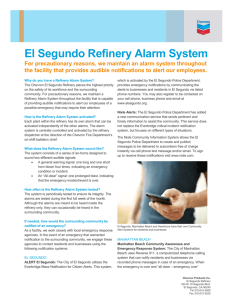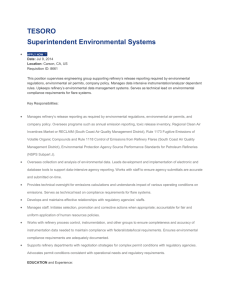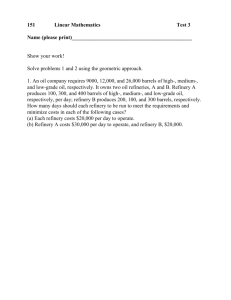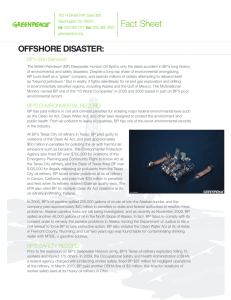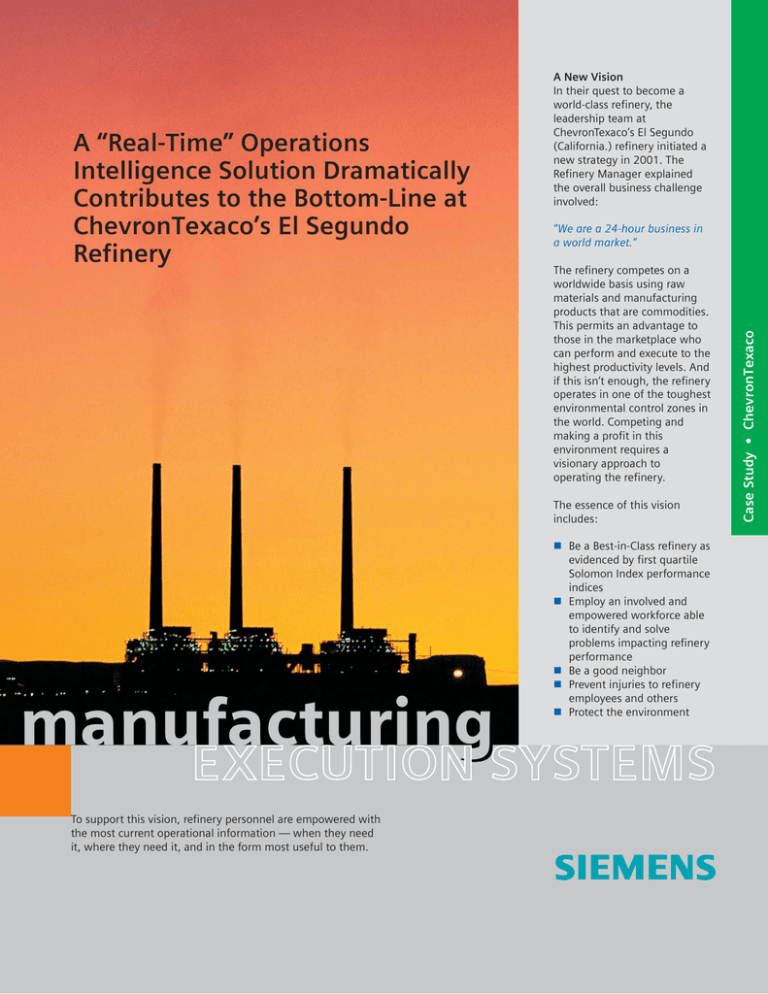
“We are a 24-hour business in
a world market.”
The refinery competes on a
worldwide basis using raw
materials and manufacturing
products that are commodities.
This permits an advantage to
those in the marketplace who
can perform and execute to the
highest productivity levels. And
if this isn’t enough, the refinery
operates in one of the toughest
environmental control zones in
the world. Competing and
making a profit in this
environment requires a
visionary approach to
operating the refinery.
The essence of this vision
includes:
manufacturing
To support this vision, refinery personnel are empowered with
the most current operational information — when they need
it, where they need it, and in the form most useful to them.
Be a Best-in-Class refinery as
evidenced by first quartile
Solomon Index performance
indices
Employ an involved and
empowered workforce able
to identify and solve
problems impacting refinery
performance
Be a good neighbor
Prevent injuries to refinery
employees and others
Protect the environment
Case Study • ChevronTexaco
A “Real-Time” Operations
Intelligence Solution Dramatically
Contributes to the Bottom-Line at
ChevronTexaco’s El Segundo
Refinery
A New Vision
In their quest to become a
world-class refinery, the
leadership team at
ChevronTexaco’s El Segundo
(California.) refinery initiated a
new strategy in 2001. The
Refinery Manager explained
the overall business challenge
involved:
Background
Over the last decade, refining oil for the U.S. gasoline
market hasn’t been easy. Environmental concerns have
imposed controls and process changes whose costs have
squeezed profit margins. Meanwhile, the vagaries of the
economy have increased uncertainties in the marketplace,
and changing political considerations have impacted
global crude supplies. Finally, new hyper-marts have come
on-scene, purchasing and importing offshore refined
gasoline at prices that domestic refiners have found
difficult to meet. This puts more pressure on domestic
refiners to reduce costs.
As the outcome of this process, supporting the strategy
ChevronTexaco management had laid out, El Segundo
implemented a real-time operations intelligence system
designed to provide operational details and key
performance metrics throughout the refinery.
El Segundo refinery management determined that to
effectively compete in this market , it would have to
concentrate its efforts on continuously improving overall
performance. They initiated this vision by first changing
traditional management behaviors. Rather than having
management direct every employee action, the new
behaviors would encourage the workforce to meet new
goals by enabling:
In operation, XHQ aggregates, relates and presents, in
real-time, operations data drawn from disparate sources
within the enterprise. Accessed via a browser, wireless
device or corporate portal, the dynamic graphical
representation XHQ affords is personalized to an
individual’s specific data needs. Easy to implement and
use, XHQ allows each user to create the “data view” they
require without help from IT staff. As the enterprise grows
or its needs change, users can easily “evolve” XHQ and
meet the new challenges.
Creativity
Initiative
Participation
This resulted in the formation of various cross-functional
teams chartered with improving operations. One of these
teams, focused on operations reliability, identified the
need to have more plant real-time information available
throughout the refinery. They believed this to be one of
the critical elements to achieving the new business
strategy.
“The drive for competitiveness demands less staff,
increased responsibilities, less boundaries and pushes
decision-making down. Chevron expects operators to
manage the process, environment and equipment.” — IT
Manager
Already, in 1999, ChevronTexaco corporate IT had initiated
a search for a solution that would provide increased realtime operational intelligence. They sought a capable
solution based on easy-to-use web technologies that
would require minimal traditional IT involvement and
ongoing support. This search turned up XHQ, an
Operations Intelligence Platform developed by Siemens.
XHQ was evaluated to determine if it met the above
needs, and initial indications were that it did. XHQ was
selected for a pilot at the El Segundo refinery. This pilot
proved successful.
El Segundo built upon this success, initiating a project
team led by people taken from the business units. This
team trained in the new technologies and began working
with the business units to implement the solution in
phases. Although IT supported the project team with
system skills, efforts here were minimal as compared to a
traditional IT-driven project.
SIMATIC IT XHQ
Siemens XHQ is an integrated Operations Intelligence
Platform. Broadly applicable across all levels of the
enterprise, XHQ enables real-time performance
monitoring and decision support, which drive improved
business performance.
In addition, XHQ employs a virtual cache for data
management, which minimizes bandwidth use and backend loading. This keeps network performance high. The
solution’s impact on source applications is negligible, and
as it resides on servers positioned between users and
backoffice systems, maintenance and associated costs are
minimal.
The Solution Implementation
A team consisting of several members of the user
community, a representative of the plant IT group and
representatives Siemens Global Services created most of
the XHQ solution content. Leadership and direction
provided by the plant IT Manager, the Refinery Focused
Operations Manager and others were also critical to the
project.
The solution work started in late 1998 and today it serves
up to 1200 local users on a 24 hours/day, 7 days/week
basis. Over 1000 different visualizations were created
against over 500 business and operational components. In
addition to all process operations data and histories, the
solution incorporates over 45 different sets of relational
data.
The Results
For the past two years, ChevronTexaco’s El Segundo
refinery has reported dramatic year- overyear results. This
puts the refinery on-target to achieving management’s
overall vision.
A recently completed Business Value Assessment study
found that the present implementation of XHQ, combined
with the newly empowered workforce, contributed
dramatically to these results. Table 1 on the next page
reflects the actual results achieved at El Segundo.
Business Improvement
Category
Multi-Year
Average
Reduced Operating Expenses
8%
Increased Facility Utilization
8.5%
Increased Operational Availability
2.5%
Increased High Value Product Production
10.5%
Reduced Environmental Incidents
18%
Reduced OSHA Recordable Injury Rate
39%
The business value assessment process found that many
improvement categories overlapped in their benefit
contributions. Most of these, though important in other
business aspects, basically contributed to reduction of
overall operating expenses.
For this reason, only two business improvement
categories were selected to calculate business benefits, as
they provide separate and straightforward benefits:
Reduced Operating Expenses
Increased HVP (High-Value Product) Production
The XHQ implementation resulted in a calculated internal
rate of return (IRR) of 339% in realized business value.
The study also established that (1) merging senior
management’s initiative to increase productivity with (2)
the new capability to access, view and act upon
information from disparate sources, provided dramatic
business unit increases in:
Overall efficiency
Utilization
Profitability
XHQ enabled these results, due to the increased focus it
affords on critical issues within the refinery’s overall
operation.
The XHQ implementation resulted in a calculated internal
rate of return (IRR) of 339% in realized business value
(corporate taxes are not included in IRR). Additional
potential benefits identified provided an additional 150%
to 200% IRR.
The stated IRRs were based on an initial Year 1 investment
plus on going support and development. The
investment/benefit model was set up for a 5-year period
and included the following costs:
XHQ License
Implementation Services
Internal Developers
Project Management
IT Support
Hardware Purchases
Software Upgrades and Support
Developer Training
User Training
“We can see problems quicker . . .” — Operations
Coordinator
“During an upset our teams can monitor the situation in
all aspects without having to be in the control room …
[and] all people will be operating off the same data
(source).”— Operations Supervisor
Study Findings
The Business Value Assessment study reveals several
valuable findings concerning the XHQ implementation
that are important to consider:
The “Sweet Spot” for Real-Time Operations Intelligence
El Segundo’s XHQ implementation demonstrates that
operations personnel derive the solution’s major realized
benefits, as they need to access a large number of
operational applications located in various systems across
the refinery. In fact, the findings support the conclusion
that the more complex the business environment, the
greater the benefits that can be derived via XHQ.
XHQ provides a refinery-wide view of real-time data and
supports drill-down capabilities to information formally
provided only by other systems (Historian or Maintenance,
for example). Those who need to look across the refinery
can without having to log onto different systems, each
having a different and complex mode of accessing data.
Planning and Scheduling
Monitoring and Trouble Shooting
As XHQ accesses information found in many different
systems through one common graphical
interface, people at all levels — planning and
coordination, supervisors, process engineers,
operators — find that they are able to identify and
address problems. In fact, they can now
anticipate problems much more quickly. El Segundo
personnel cite XHQ capabilities as leading
“It (XHQ) provides at least a 10% -15% improvement in
anticipating (process) problems.” — Unit Supervisor
XHQ Provides Real-Time Operations Intelligence
One of the major benefits of XHQ is its ability to enable
users to examine what is happening across the refinery.
The system provides quick and easy access to a myriad of
systems (and their relevant data) that support crucial realtime business decisions. Specifically, XHQ:
Enables management and employees to focus on the
metrics used to run the refinery.
Is easy to use and non-intrusive (web browser-based).
Enables broader process knowledge at all levels in
operations.
Enhances troubleshooting and communication.
Can access information anywhere in the refinery;
sources of information are not limited.
Supports operations training.
Provides users with a common source of data and can
be integrated as required.
Can be configured so that information views support
specific job roles, including drilldown capabilities into
equipment, process values, lab, maintenance, logs,
energy utilization, environmental monitoring,
management metrics.
“We now have more ‘eyes’ looking at a problem.”
— Operations Coordinator
Critical Success Factors
Based on El Segundo’s successful implementation of XHQ,
five factors have been identified that are considered
critical to that success:
CSF 1: Senior Management Commitment
The most outstanding characteristic of the El Segundo
study is the vigor with which senior management
supports the project. The Refinery Manager sees the
project as important, stating publicly that it is key in
achieving his vision for the refinery. He has a monitor in
his office where XHQ actively displays an overview of the
refinery, allowing him to monitor real-time
refinery metrics.
Additionally, management has committed senior, able,
responsible business people. Without this commitment
and the funding to go along with it, this project would
note the success it is today.
CSF 2: Business Needs (Requirements) Drive Product
Capabilities
The process industry is full of example IT projects that
failed because application capabilities implemented didn’t
adequately match business needs. Consequently, these
applications weren’t used, as they didn’t provide the
results promised.
XHQ is an application that fits El Segundo’s business
needs very well. As stated earlier, competitive pressures
are driving changes in the way work is performed in the
refinery. Decision-making is being pushed down to the
people who do the work. This, in turn, necessitates
providing these workers with more timely and relevant
information from various system sources existing within
the business. XHQ’s ability to quickly and easily access
information contained in various custom applications,
then present it to the business user in an easily
understood format makes it an application that fits this
business need.
CSF 3: Ownership/Lead by Business Groups
In many failed IT projects, the systems fail to provide the
benefits advertised or needed. The Gartner Group
estimates that as many as 25% of IT projects fail to meet
expectations. At El Segundo, this was recognized as a
priority and users were empowered to make the project
happen. Consequently, they took ownership of the project
and led its implementation. This wasn’t just another IT
project.
The enthusiasm and excitement that El Segundo’s
personnel feel about the technology and project is clear
and unmistakable. They call it the system “by the users
and for the users,” and they mean it. The system belongs
to the business and is led by the business. Refinery
employees see it as part of their job and they will not
allow it to fail.
CSF 4: Expectations Realistically Established
At El Segundo the project team spent time with refinery
personnel talking about XHQ’s capability to connect to the
systems that are important to them. They began early on
to formulate expectations without overpromising the
system’s capabilities. Expectations were then realistically
set and managed. (This is especially important for new
technologies. When it comes to introducing these, the
rule of “No Surprises” is a good one to follow.)
CSF 5: Match Implementation to Culture
It is critical that project implementation strategies and
approach match the culture where the technology is to be
introduced. El Segundo has long had a culture that
encourages employees to be innovative and empowers
them to make things happen. A participative approach to
problem solving is the norm in El Segundo’s culture.
A traditional IT-led project, based on a strict line and staff
organizational approach, would not have yielded the
magnitude of results seen today at El Segundo. IT
supported the project effort and provided expertise where
it was required. We believe this is a trend that will become
the foundation for implementing future successful
technology projects.
Summary
The management initiative at ChevronTexaco’s El Segundo
refinery — enabled with the highly capable Siemens
SIMATIC IT XHQ real-time operations intelligence solution
— is achieving the facility’s business vision of becoming a
world-class refiner. Compelling business results have
already been realized using XHQ and more are planned,
making this solution a serious consideration for any major
business enterprise looking to reach that next level of
overall productivity.
“Everyone is aware of our key metrics and we all monitor
how we are performing. We are all part of the same team
and we share in success together.” — Operations
Supervisor
Conclusion
Real-time operations intelligence is critical to achieving
significant business improvement Siemens SIMATIC IT
XHQ has proven to efficiently and cost effectively provide
this capability by basing their solution on easy-to-use and
implement web-based technologies. This solution applies
to any business with complex operational requirements.
Another major international oil company backed up these
findings. At the 2002 XHQ Conference, the company
outlined its continuing commitment to rollout XHQ to all
of its refineries worldwide. Positive results concerning the
use of XHQ in other business segments, such as food and
beverage, automotive, and chemical industries, were also
reported during this conference.
About The Authors
Mr. P. Bruce Guthridge
A founding member of IT Executive Partners and a
managing partner in the firm. He has been a
management and technology consultant for the last 15
years, including participation at Gemini Consulting and
Oracle Energy. Mr. Guthridge’s expertise includes business
process design, IT investment justification and IT strategy
development. He is the architect of the “Three
Dimensional ROI” justification approach.
Mr. Guthridge led the Information Technology section of a
multi-year international research study on Computer
Integrated Manufacturing led by Purdue University, and
sponsored by several major technology and energy
companies. He has authored several white papers on IT
investment justification. Mr. Guthridge holds a BS degree
in Mathematics. He can be reached at
pbguthridge@itexecutivepartners.com.
Mr. Bill D. Parker
A founding member of IT Executive Partners and a
managing partner in the firm. He has been a
management and technology consultant for the last 15
years, including experience at A.T. Kearney, EDS and SHL
Systemhouse. Mr. Parker is especially skilled in assessing
corporate business processes to improve operational
performance. His expertise ranges from business process
design and operational change management to strategic
e-business planning, primarily in the energy and
manufacturing industries.
Mr. Parker has been a frequent attendee at the NPRA
Maintenance Conferences and has worked with the
American Petroleum Institute’s Reliability Based
Maintenance initiatives. He has been a speaker at the
national APICS conferences and has authored several
articles, including “Why CMMS Implementations Fail,” which
was published in Maintenance Technology Magazine. He
can be reached at bdparker@itexecutivepartners.com.
About Siemens
Siemens Energy & Automation, Inc. is one of Siemens
operating companies in the U.S. Headquartered in the
Atlanta suburb of Alpharetta, GA, Siemens Energy &
Automation, Inc. manufactures and markets one of the
world's broadest ranges of electrical and electronic
products, systems and services to industrial and
construction market customers. Its technologies range from
circuit protection and energy management systems to
process control, industrial software and totally integrated
automation solutions. The company also has expertise in
systems integration, technical services and turnkey
industrial systems. For more information:
www.sea.siemens.com.
Siemens AG (NYSE:SI) is one of the largest global
electronics and engineering companies with reported
worldwide sales of $107.4 billion in fiscal 2006. Founded
nearly 160 years ago, the company is a leader in the areas
of Medical, Power, Automation and Control, Transportation,
Information and Communications, Lighting, Building
Technologies, Water Technologies and Services and Home
Appliances. With its U.S. corporate headquarters in New
York City, Siemens in the USA has sales of $21.4 billion and
employs approximately 67,000 people throughout all 50
states and Puerto Rico. Eleven of Siemens' worldwide
businesses are based in the United States. With its global
headquarters in Munich, Siemens AG and its subsidiaries
employ 475,000 people in 190 countries. For more
information on Siemens in the United States:
www.usa.siemens.com.
About IT Executive Partners, LLC
IT Executive Partners provides consulting services that
begin early in an Information Technology evaluation
process and continue through to monitoring business
results. This includes assessing current capabilities,
recommending strategies, identifying/evaluating potential
business benefits/risks, and providing quality monitors to
help assure business potentials are realized. The premier
service provided is Business Value Assessment for potential
IT business investment. It is based on the Three
Dimensional ROI approach, which creates a reasoned
business basis for investment decisions. For more
information, visit www.itexecutivepartners.com.
© 2010, Siemens.
All Rights Reserved.
Subject to change without prior notice.
Trademarks mentioned in this document are the property of Siemens AG,
its affiliates, or their respective owners.
The information in this document contains general descriptions of the
technical options available, Which may not apply in all cases.
The required technical options should therefore be specified in the contract.
Siemens Pte, Ltd
The Siemens Centre
60, MacPherson Road
Singapore 348615
Phone: +65 6490 6794
oilgasconsulting.sg@siemens.com
http://sg.siemens.com/oilgasconsulting/Pages/Index.aspx

